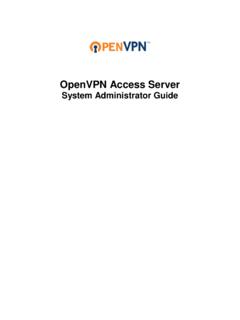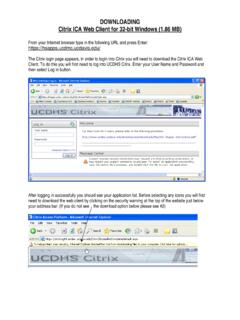Transcription of RLM License Administration - Reprise Software
1 RLM License AdministrationRLM , 2017 ContentsSection 1 License Management IntroductionIntroduction .. 5 What's New in RLM .. 7 Section 2 License Administration BasicsInstalling an RLM-licensed Product .. 9 The License Server .. 11 The License File .. 19 HOST 20 ISV 20 License 22 UPGRADE 33 The License 36 License Administration Tools .. 38 The RLM Web 45 The RLM Options File .. 57 The ISV Options File .. 62 Section 3 Advanced TopicsToken-Based Licenses .. 75 How to Queue for Licenses .. 78 How to use Roaming Licenses .. 79 Failover License Servers .. 81 Transferring Licenses to Another Server .. 84 Section 4 Reference MaterialRLM Environment Variables .. 88 RLM Performance Testing .. 91 Reportlog File Format .. 94 RLM hostids .. 105 Optional hostid Installation Instructions .. 107 IPv6 Considerations .. 111 RLM Status Values .. 112 RLM Version History .. 119 Revision History.
2 127 RLM License Administration ManualPage 2 of 127 RLM License Administration - Copyright (c) 2006-2017, Reprise Software , IncRLM - Reprise License Manager - Copyright (c) 2006-2017 Reprise Software , IncReprise License Manager TM Copyright 2006-2017, Reprise Software , Inc. All rights Demo, Open Usage, Reprise License Manager, RLM Activation Pro, RLM, RLM-Embedded and TransparentLicense Policy are all trademarks of Reprise Software , contains Software developed by the OpenSSL Project for use in the OpenSSL Toolkit ( )RLM contains Software (the GoAhead WebServer) developed by GoAhead Software , Inc. ( )RLM License Administration ManualPage 3 of 127 Section 1 License ManagementIntroductionRLM License Administration ManualPage 4 of 127 IntroductionAbout this ManualThis manual describes setup and maintenance of the RLM licensing system, and as such it is intended for License administrators and users at organizations which have purchased Software which uses the Reprise License Manager.
3 This manual explains how to install and configure the licensing system included with your Software . Introduction To RLMYou are most likely reading this manual because one or more of your Software vendors (ISVs) have included RLM in their product(s) to enforce their License agreements. This manual describes the components of RLM that you need to understand in order to accomplish day-to-day License Administration allows your organization to know that you are using purchased Software within the License limits set by your ISV. In addition, RLM collects usage information (at your option) for later reporting and analysis. This usage information is provided in a fully-documented report log format, described in Appendix A of this one of your ISVs delivers Software to you that incorporates RLM, in addition to the normal application files, you will receive some additional RLM components: the rlm (generic) License server provided by Reprise Software , called "rlm" on Unix systems, or " " on Windows.
4 This is the same for every ISV who uses RLM. the rlm utilities ("rlmutil" on Unix, " " on Windows) provided by Reprise Software . This is the same for every ISV who uses RLM. A custom License server, built from components from Reprise Software by your ISV. Thisserver will have a different name for each ISV. a License file to describe your rights to the product. This License file is unique to your addition to these components which your ISV supplies, you can create an ISV options file to control various aspects of operation of each licensed product. This options file is described later inthis manual. In addition, an RLM options file allows you to restrict access to various Administration is a client-server system, with License requests transmitted over TCP/IP from the Software application to a License server that controls License usage sets RLM apart?RLM was designed from the start to emphasize openness, transparency, and is open because we publish the format of our report log file, so that you can always examineand generate usage reports on licensing activity from the RLM License Administration ManualPage 5 of 127 RLM is transparent in the sense that we do not allow "back doors" which lead to unique behaviors from one ISV to another.
5 In addition, we have removed policy from the application code, and placed it into the License key itself, so that everyone will be able to understand the License terms without having to understand a particular implementation by an ISV. RLM is simple because we include functionality like truly automatic selection of License servers from a set of multiple, independent servers. In older License management systems, the ISV ends upwriting much code to manage multiple License servers. This is handled by RLM License Management BasicsRLM is similar in structure to most popular License managers. RLM consists of 3 major client License server (RLM has 2 License servers - a generic server called rlm and an ISV-specific server.) text file which describes the licenses granted (the License file).Your ISVs application is linked with the client library which provides access to the License management functions. The License server is used for floating licenses and logging of usage data.
6 You, as a License Administrator, have the ability to control certain aspects of the License server's operations by specifying options in a file called the ISV Options RLM client library (linked into your ISVs application) and the License server are both controlled by License authorizations stored in a text file called the License file. Most License managers provide APIs with calls to control many of the aspects of licensing behavior, as well as options within the License servers to control licensing behavior. The design philosophy of RLM is to preserve the simplicity of the system for both ISVs and License Administrators by avoiding all unnecessary options in the client library and the License servers andmoving all these options to the License file, where they are visible and understandable by everyone. In general, License policy should be kept out of the application and the License server, and placed into the License itself.
7 This makes for a more understandable licensing system for both ISVs and License Administrators. The API is simpler, and the License server performs in a more standard way from ISV to ISV. This prevents License management confusion by customers. We learned this the hard way when we supported hundreds of customers in the past, and applied these lessons to the design of RLM. RLM License Administration ManualPage 6 of 127 What's New in RLM section lists the new features in RLM , along with pointers to the relevant sections in the manual. rlmstat now takes the -I switch to print the ISV-defined data. See the rlmstat section of the License Administration Tools chapter on page 38 for more information. The report log INUSE records now include the share handle for shared licenses. SeeReportlog File Format on page 94 for more information. The specification of a primary server in an rlm_failover_server License can now omit the port #.
8 If omitted, the default port (5053) is used. See Failover License Servers on page 81 for more information. The < , > , & , single quote(') and back quote(`) characters are now legal characters in the customer field of the License . The UUID hostid type is added on Windows systems. The UUID is the BIOS uuid value. Generate this hostid with rlmutil rlmhostid uuidRLM License Administration ManualPage 7 of 127 Section 2 License Administration BasicsThis section of the manual contains the information you need to install andmanage your purchased applications which use the RLM License License Administration ManualPage 8 of 127 Installing an RLM-licensed ProductWhen you receive a product licensed with RLM, your Software Provider (or Independent Software Vendor, referred to in this manual as your ISV ) will provide an installation procedure that installs the License management components (in the case of floating licenses, this is typically separate from the installation procedure for the application, since the License server processes usually run on a different machine from the application).
9 Your ISV will generally make the licensing installation as transparent as some cases, your ISV will not provide you an installation procedure for the License server (the License server is required for floating licenses only it is not required for nodelocked licenses). This might happen, for example, if you want to run the server on a platform which your ISV does not support. The remainder of this section describes a manual RLM server installation, in the eventyou need to install it yourself or troubleshoot your , you need the three required licensing components for the License server: The generic License server, rlm on Unix, on Windows. The ISV's License server, either a settings file named , or a binary named isv on Unix, on Windows. The License file which describes your rights to the , you might want the RLM utilities - rlmutil on Unix, on Windows. These utilities are often installed as their separate command names, see License Administration Tools on page the easiest installation, place all three components in the same directory (put the utilities, if you want to install them, in that directory as well.)
10 In this way, License servers, utilities, and application programs will all be able to locate the License without any additional environment settings for users. All that remains to get floating licensing working is to start the License servers. (Note: if you did not locate the License file (or a link to it) in the binary directory, you need to provide a pointer to the License file (or License server) to the application, using the RLM_LICENSE environment variable.)To start the License server (again, only required for floating, or counted licenses) the License file into the binary directory (or startup directory) and name it If you do not do this, then set the RLM_LICENSE environment variable to the path of the License the rlm command:% rlm > output_fileTo enable your users to find the License file or License server, the License file (named ) in the binary directory with the application program (RECOMMENDED), RLM_LICENSE license_file_path, RLM_LICENSE port@host, where port is the port # in the License file, and host isthe hostname in the License License Administration ManualPage 9 of 127 Note.







